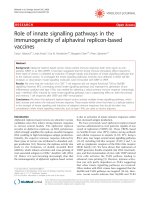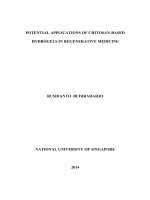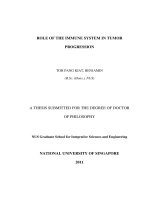role of narrative based medicine in proper patient assessment
Bạn đang xem bản rút gọn của tài liệu. Xem và tải ngay bản đầy đủ của tài liệu tại đây (322.68 KB, 4 trang )
Support Care Cancer
DOI 10.1007/s00520-017-3637-4
SPECIAL ARTICLE
Role of narrative-based medicine in proper patient assessment
Giovanni Rosti 1
Received: 5 October 2016 / Accepted: 27 December 2016
# The Author(s) 2017. This article is published with open access at Springerlink.com
Abstract Improving patient-physician communication is an
area of medicine that deserves greater attention. Narrative
medicine can be considered as one tool that can aid in fostering better communication. Current medical practice is dominated by evidence-based medicine, and dictates what therapies
the clinician will offer in a given circumstance, ideally supported by (evidence-based) guidelines. However, when taken
alone it tends to decentralize the patient. There are many different approaches that can be used to understand the patient
and what he or she is experiencing as a result of their illness.
While time constraints are often mentioned as a barrier to
improved communication, in reality the time required to listen
to patients is not excessive, and all caregivers should reflect on
the possibility to give patients greater freedom from time constraints during consultation, and encourage them to narrate
their experiences. Moreover, use of narrative-based medicine
may be associated with better diagnosis and treatment of pain.
Narrative-based medicine is not just for end-of-life care, but
something for all caregivers to give greater consideration to in
daily practice in order to form a strong frame of alliance.
Keywords Cancer . Narrative-based medicine .
Patient-physician communication . Diagnosis . Treatment .
End-of-life
Improving patient-physician communication is an often
overlooked area of medicine. However, it is certainly one that
deserves greater attention due to the complexity of the patient
* Giovanni Rosti
1
Oncology, Policlinico San Matteo IRCCS, Pavia, Italy
journey that includes multimodality therapies, side effects,
and especially, the prognostic outlook of cancer.
Patients may have difficulty in communicating to physicians, and in turn, physicians may also have difficulty, for
many reasons, to properly assess patient’s needs. Consider,
for example, a retired man with metastatic prostate cancer
who when asked by his physician rates his pain as 3. For the
physician, this would be considered mild pain, and therapy
would be continued with no changes. However, the physician
could, for example, query the man about the impact that this
mild pain has on his quality of life. Being retired, he might say
that even if the pain is mild, he is no longer able to carry out
daily activities that he would otherwise have a strong desire to
continue. He used to be able to help his son out at the hardware
store moving boxes and staying at the cash register, talking
with old friends. With his mild pain, he no longer feels up to
this, and so he must stay at home. Obviously, this has a large
impact on his social and daily life. Better communication with
patients, and trying to understand the individual issues that
affect them, and how they perceive and deal with even mild
pain, as in this case, could help the physician to understand
that a pain score of 3 may be considered as a relative score that
actually merits better treatment. In such a context, better communication through narrative medicine can have a beneficial
effect on the patient’s overall quality of life.
The definition of narrative medicine
Narrative medicine can be considered as a medical educational tool that is informed by reading, writing, telling, and receiving stories. It invites one to be moved by the story of illness,
and promotes a healing relationship with patients, colleagues,
and the self. The concept of narrative medicine was first
established by Dr. Rita Charon. In her opinion, narrative
Support Care Cancer
medicine is a model for empathy, reflection, profession, and
trust, and was proposed as a Bmodel for humane and effective
medical practice^ [1]. Furthermore, narrative medicine fortifies Bclinical practice with the narrative competence to recognize, absorb, metabolize, interpret, and be moved by the
stories of illness^ [2]. Narrative medicine has been studied
as a means of training medical students and enhancing developing clinical skills [3]. Training in narrative medicine was
found to develop and improve specific communication skills,
enhance the capacity to collaborate, empathize, adopt a
patient-centered approach, and help physicians to develop personally and professionally through reflection. Thus, narrative
medicine can have several benefits that may help improve
daily practice and achieve narrative competence (Fig. 1).
Narrative vs. evidence-based medicine
Current medical practice is dominated by evidence-based
medicine, or that supported by a variety of clinical evidence,
the highest being meta-analyses and randomized, controlled,
and blinded clinical trials. Evidence-based medicine dictates
what therapies the clinician will offer in a given circumstance,
ideally supported by (evidence-based) guidelines. While
evidence-based medicine is a cornerstone of current medical
practice, when taken alone it tends to decentralize the
patient while ignoring the narrative from a more personal perspective. However, a newer narrative approach has the aim of
combining evidence-based and narrative-based approaches, or
Bfact finding^ with empathy, to create what could be considered as the Bart of medicine^ [4]. In this vision, medicine is not
only caring for the patient’s illness, but also how the illness is
perceived, engaging the caregiver in real-life experiences.
Thus, obtaining information about the patient through a narrative approach and routine clinical anamnesis cannot be considered to be comparable. There are different approaches to
understanding the patient and what he or she is experiencing
as a result of their illness. It is also important to understand that
narration is communication, but narration, or communication
can also be achieved through non-verbal channels that might
include drawings, videos, paintings, and pictures to name a
few. A simple drawing can be used to describe episodes of
Fig. 1 Goals of narrative
medicine
pain, for example, and watching a short video may be helpful
for the patient to communicate feeling that they find difficulty
in directly expressing. The idea that visual images can help to
communicate pain has been previously highlighted by
Padfield [5].
Time constraints in a busy world
Clinical practice that includes narration introduces a potential
barrier to its inclusion in daily routines, namely, that clinicians, in today’s time constraint environments constantly being pushed towards greater efficiency, do not have the time to
dedicate to listen to patients. Physicians and other caregivers
may feel that they risk being overwhelmed by patient complaints if they listen until the patient is finished. To counter
such an argument, data from a previous study can be cited in
which physicians were trained in active listening techniques,
and were asked to not interrupt patients during the initial phase
of the consultation [6]. In this context, mean spontaneous
talking time was only 92 s, and 78% of patients concluded
their initial statement within 2 min. From that study, the authors concluded that Beven in a busy practice driven by time
constraints and financial pressure, 2 min of listening should be
possible and will be sufficient for nearly 80% of patients^.
Considering this, all caregivers should reflect on the possibility to give patients greater freedom from time constraints during consultation, and encourage them to narrate their
experiences.
Recognizing the individual, not the patient
As an example, narrative medicine can be recommended for
better diagnosis of pain and its treatment (Fig. 2). Narrative
medicine can complement more traditional evaluation techniques. In the case of pain, evaluation with VAS is commonly
used to give the patient’s pain a score that will drive treatment.
Narrative evaluation, however, assesses the impact that the
pain has on the patient’s daily activities and quality of life.
Together, both evaluation techniques can help the caregiver
to remember that individuals are being treated, and not just
Narrative competence
Empathy
Professionalism
Trustworthiness
Support Care Cancer
Fig. 2 Narrative medicine in
diagnosis and treatment of pain
Narrative Medicine in diagnosis and treatment of pain
VAS evaluation
Narrative evaluation
Ranking my pain
The impact of pain on me
An individual, not a patient
patients, each of whom have their own subjective problems
related to their disease and its consequences. As an example,
the impact of narrative medicine in cancer pain has been studied in a trial that randomized 234 patients to a narrative group
(patients wrote a story about their pain), a questionnaire group
(patients filled out the McGill Pain Questionnaire), and a control group (usual care) [7]. While pain intensity was similar
between groups both before and after treatment, patients
whose narratives had high emotional impact had significantly
less pain than patients whose stories were less emotional.
Indeed, both high- (such as questionnaires and assessment
tools) and low-context approaches (such as story-telling) help
to understand and share the experience of illness: both are
important and both are necessary [8]. Referred to as narrative
empathy, many believe that the process can aid in decision
making and improve overall outcomes [8].
Narration is not an easy task as it can involve subjects that
may not seem clinically relevant for the patient’s care, giving
precedence to the disease over the individual’s overall wellbeing. This possibility was highlighted very well by the writer
Souleika Jaouad, who was diagnosed with leukemia at the age
of 22. In communicating about her experience with her treatment, she noted that Bto my surprise, sex is not at the center of
the conversation in the oncology unit — far from it^ [9].
Furthermore, she said that the issues of sexuality and infertility
had never been mentioned during her treatment. While caregivers may feel uncomfortable talking about such issues with
their patients, they should also be aware that as individuals
they may be confused and frustrated by the lack of communication about sensitive subjects.
What narrative medicine is and is not
There are many misconceptions about narrative medicine.
Among these, it should not be considered as useful for only
psychiatrists, psychologists, or palliative care physicians.
Narrative medicine is also not something that should be applied only to patients needing end-of-life care, and should not
be viewed with a negative attitude. It is, on the other hand,
about listening to the patient about aspects that may not normally be expressed during a Broutine^ visit. It is also about
providing greater empathy throughout the patient journey,
during all aspects of diagnosis and treatment. As mentioned
earlier, proper training in narrative medicine at an early stage
may improve communication skills [3]. Narrative medicine,
thus, is something for all caregivers. In order to achieve this, a
strong frame of alliance is needed. Such a framework should
Fig. 3 Frame of alliance for
narrative medicine
Nurse
Physician
Patient
Caregiver
Support Care Cancer
include not only the physician, but also nurses and other caregivers, working together with the patient (Fig. 3).
Future perspectives for narrative medicine in daily
practice
Undoubtedly, medicine has made great strides in recent years
in terms of the use of a number of new technologies. So-called
e-health technologies will possibly allow building bridges as
patients can be in closer contact with their healthcare providers. It is possible that new technologies could give clinicians more time for narrative techniques with patients. On the
other hand, increased use of digital technologies could potentially reduce the opportunity for narrative contact, yet provide
a starting point for discussion, such as with an electronically
transmitted patient pain diary. Undoubtedly, the impact of new
technologies will emerge once their use is more consolidated
in the future. Nonetheless, BEven ‘evidence-based’ clinicians
uphold the importance of clinical expertise and judgment^
[10]. The clinician must also rely on patient narration to complement more objective clinical results. While on one hand, an
evidence-based approach is needed, it should also be kept in
mind that the art of medicine involves applying knowledge to
a single individual. In the words of Rita Charon, BTo listen to a
story of illness is not a therapeutic act, but it gives dignity and
honor to that voice^. Clinical methods are not without their
limitations that narrative medicine can help to overcome.
Acknowledgements I would like to thank all patients and families I
met throughout my years as a Medical Oncologist.
Compliance with ethical standards
Funding None.
Conflict of interest The author received honoraria from Teva
Pharmaceuticals Europe B. V for speaking at BeCOn OWN medical
education event, supported by Teva Pharmaceuticals Europe B.V. Dr.
Rosti declares that he has no conflict of interest.
Open Access This article is distributed under the terms of the Creative
Commons Attribution-NonCommercial 4.0 International License (http://
creativecommons.org/licenses/by-nc/4.0/), which permits any noncommercial use, distribution, and reproduction in any medium, provided
you give appropriate credit to the original author(s) and the source, provide a link to the Creative Commons license, and indicate if changes were
made.
References
1.
Charon R (2001) The patient-physician relationship. Narrative
medicine: a model for empathy, reflection, profession, and trust.
JAMA 286:1897–1902
2. Charon R (2007) What to do with stories: the sciences of narrative
medicine. Can Fam Physician 53:1265–1267
3. Arntfield SL, Slesar K, Dickson J, Charon R (2013) Narrative medicine as a means of training medical students toward residency
competencies. Patient Educ Couns 91:280–286
4. Charon R (2013) Narrative medicine: caring for the sick is a work
of art. JAAPA 26:8
5. Padfield D (2011) BRepresenting^ the pain of others. Health
(London) 15:241–257
6. Langewitz W, Denz M, Keller A, Kiss A, Ruttimann S, Wossmer B
(2002) Spontaneous talking time at start of consultation in outpatient clinic: cohort study. BMJ 325:682–683
7. Cepeda MS, Chapman CR, Miranda N, Sanchez R, Rodriguez CH,
Restrepo AE et al (2008) Emotional disclosure through patient narrative may improve pain and well-being: results of a randomized
controlled trial in patients with cancer pain. J Pain Symptom Manag
35:623–631
8. Moore RJ, Hallenbeck J (2010) Narrative empathy and how dealing
with stories helps: creating a space for empathy in culturally diverse
care settings. J Pain Symptom Manag 40:471–476
9. New York Times Available at: https://wellblogsnytimescom/2013
/02/14/life-interrupted-crazy-unsexy-cancer-tips
10. Greenhalgh T (1999) Narrative based medicine: narrative based
medicine in an evidence based world. BMJ 318:323–325









